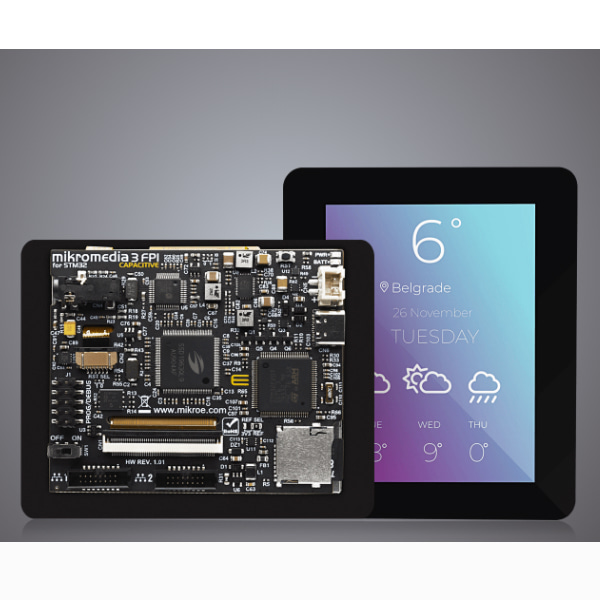STM32F2 3.5인치 정전식 터치 디스플레이 멀티미디어 개발 보드 -베젤
(Mikromedia 3 for STM32F2 Capacitive FPI with bezel)


개요
- 본 제품은 STM32F2 3.5인치 정전식 터치 디스플레이 멀티미디어 개발 보드 -베젤입니다.
- STM32F207VGT6 MCU, 3.5인치 정전식 터치 디스플레이, USB, 모션센서, 배터리 충전회로,등등의 주변모듈 및 GPIO 접근이 가능한 핀 패드를 지원합니다.
- 빠른 GUI 개발이 가능한 Visual TFT 소프트웨어와 MikroC 컴파일러를 지원합니다.
특징
-
Mikromedia 3 for STM32F2 CAPACITIVE FPI with bezel is not limited to multimedia-based applications only. USB, digital motion sensor, battery charging functionality, SD card reader and much more expands its use beyond the multimedia.
Mikromedia 3 for STM32F2 CAPACITIVE FPI with bezel has two mikroBUS™ Shuttle connectors, a brand-new addition to the mikroBUS™ standard in the form of a 2x8-pin IDC header with 1.27mm (50mil) pitch. mikroBUS™ Shuttle extension board is an add-on board equipped with the conventional mikroBUS™ socket, which ensures compatibility with 950 Click boards™.
-
Awesome graphics on MCU driven TFT
Mikromedia 3 for STM32F2 CAPACITIVE FPI with bezel is a compact development board designed as a complete solution for the rapid development of multimedia and GUI-centric applications. By featuring a 3.5" TFT display with capacitive touch screen driven by the powerful graphics controller that can display the 24-bit color palette (16.7 million colors), along with a DSP-powered embedded sound CODEC IC, represents a perfect solution for any type of multimedia application.
-
Develop-on & build-in the same board
Mikromedia 3 for STM32F2 CAPACITIVE FPI with bezel is designed as the complete solution which can be implemented directly into any project, with no additional hardware modifications required. TFT display with bezel is ideal for handheld devices and for most applications, a nice stylish casing is all that is needed to turn the Mikromedia 3 for STM32F2 CAPACITIVE FPI with bezel development board into a fully functional, high-performance, feature-rich device. At its core, there is a powerful 32-bit STM32F207VGT6 microcontroller, produced by STMicroelectronics, which provides sufficient processing power for the most demanding tasks. This board requires the use of an external programmer and debugger, preferably CODEGRIP or mikroProg. The microcontroller can be programmed and debugged over the JTAG/SWD compatible 2x5 pin header, labeled as PROG/DEBUG.
-
Sound, connectivity & expandibility
Resource-demanding and complex audio processing tasks can be offloaded from the host MCU by utilizing a dedicated audio CODEC IC, labeled as VS1053B. This IC supports many different audio formats, commonly found on various digital audio devices.
This development board is not limited to multimedia-based applications only. USB, digital motion sensor, battery charging functionality, SD card reader, and much more expands its use beyond the multimedia.
-
State of the art power supply, Display & Graphics controller
A high-quality 3.5" TFT true-color display with a capacitive touch panel is the most distinctive feature of the mikromedia 3. The display has a resolution of 320 by 240 pixels, and it can display up to 16.7M of colors. The display module is controlled by the SSD1963 graphics driver IC from Solomon Systech. This is a powerful graphics coprocessor, equipped with 1215KB of frame buffer memory. It also includes some advanced features such as the hardware accelerated display rotation, display mirroring, hardware windowing, dynamic backlight control, programmable color and brightness control, and more.
The Power Supply Unit (PSU) provides a clean and regulated power, necessary for a proper operation of the mikromedia 3 development board. It is equipped with two different power supply inputs, offering all the flexibility that mikromedia 3 needs.
-
More connectivity
The microSD card slot allows storing large amounts of data externally, on a microSD memory card. The microSD card detection circuit is also provided on the board.
The host MCU is equipped with the USB peripheral module, allowing simple USB connectivity.
There are two mikroBUS™ Shuttle connectors on the development board, labeled as MB1 and MB2. Typically, a mikroBUS™ Shuttle connector can be used in combination with mikroBUS™ Shuttle extension board but is not limited to it. mikroBUS™ Shuttle extension board is an add-on board equipped with the conventional mikroBUS™ socket and four mounting holes. It can be connected to the mikroBUS™ Shuttle connector by a flat cable. This ensures compatibility with the huge base of Click boards™.